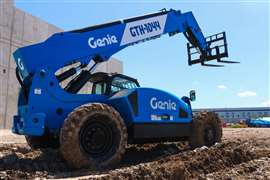Read this article in Français Deutsch Italiano Português Español
What the new US–EU trade deal could mean for construction
28 July 2025
A new trade agreement between the United States and European Union will introduce a baseline 15% tariff on most European exports while maintaining higher duties on key construction inputs such as steel and aluminium.
 US President Donald Trump shakes hands with European Commission President Ursula von der Leyen following announcement of a trade deal between the US and EU. Image: Reuters/Evelyn Hockstein
US President Donald Trump shakes hands with European Commission President Ursula von der Leyen following announcement of a trade deal between the US and EU. Image: Reuters/Evelyn Hockstein
The deal, announced 27 July, also includes carve-outs for strategic goods and long-term EU commitments to purchase US energy and defence-related products.
The framework could influence sourcing strategies, infrastructure demand and project planning in the years ahead.
Here are three key takeaways for the construction industry.
1) Tariff costs on European materials remain high
The agreement prevents a broader trade conflict but leaves in place significant cost pressures on key inputs.
While most EU goods exported to the US will face a standard 15% tariff, duties on steel and aluminium products will remain as high as 50% for some categories, depending on origin and classification.
Although the deal reduces uncertainty compared to previous US levies, it may add further volatility to bids and budgets on projects with transatlantic supply chains. Contractors sourcing specialised materials or machinery from Europe – including structural steel, construction glass or lifting and drilling equipment – could be most affected.
2) EU investment in US energy and defence may drive infrastructure demand
As part of the agreement, the EU has pledged more than US$750 billion in energy imports and $600 billion in military and industrial investment over the next three years.
Full details have not been disclosed, but the commitments are expected to support infrastructure development tied to LNG terminals, power transmission, grid upgrades and defence manufacturing.
This could create downstream opportunities for contractors in engineering, procurement and construction roles, particularly in the energy and logistics sectors.
3) Some inputs escape tariffs under zero-for-zero provisions
The deal includes carve-outs that reportedly remove tariffs entirely for specific categories, such as semiconductor equipment, aerospace components and selected chemicals and raw materials.
While not directly aimed at construction, these exemptions may benefit firms sourcing components related to power infrastructure, automation systems or advanced manufacturing. Contractors involved in large-scale industrial builds could gain flexibility on selected imports, especially where European-made systems play a role in plant assembly or fabrication.
However, the list of exempt goods remains limited and does not appear to include core building materials.
Next steps
The agreement will be implemented in phases, with the first provisions entering effect on 1 August via executive order. Further clarification is expected on enforcement mechanisms and tariff exclusions.
In the meantime, contractors with active EU supply relationships or exposure to defence and energy markets should review sourcing assumptions and monitor forthcoming procurement tied to US–EU infrastructure investment.
STAY CONNECTED


Receive the information you need when you need it through our world-leading magazines, newsletters and daily briefings.
CONNECT WITH THE TEAM












